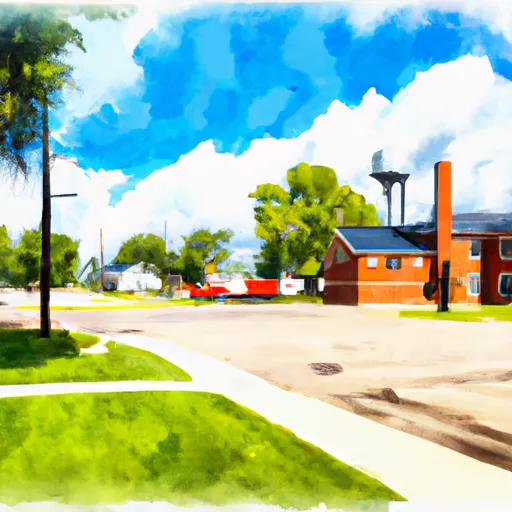-
 Snoflo Premium
Snoflo Premium
Get unlimited access to all our content
With no Ad interruptions! - Start Your Free Trial Login with existing account
Akeley
Eden Index
Climate
5.2
•
Recreation
2.8
•
Community
•
Safeguard
3.1/10

Akeley is a small town in northern Minnesota with a population of under 500 people. The area experiences a cold and snowy climate, with an average annual temperature of 41°F and an average annual snowfall of around 50 inches. The town is surrounded by several lakes, including Big Chippewa Lake and the Crow Wing Chain of Lakes, making it a popular destination for fishing, boating, and other water-based activities. The lakes are also important hydrology constituents, providing drinking water for the town and surrounding areas. In addition to outdoor water activities, Akeley is also a great place for hiking, camping, and wildlife viewing. The area is home to several state parks and recreation areas, including Itasca State Park, which is home to the headwaters of the Mississippi River.
What is the Eden Index?
The Snoflo Eden Index serves as a comprehensive rating system for regions, evaluating their desirability through a holistic assessment of climate health, outdoor recreation opportunities, and natural disaster risk, acknowledging the profound impact of these factors on livability and well-being.
Climate Health Indicator (CHI): 5.2
Akeley receives approximately
690mm of rain per year,
with humidity levels near 84%
and air temperatures averaging around
5°C.
Akeley has a plant hardyness factor of
3, meaning
plants and agriculture in this region thrive during a short period during spring and early summer. Most
plants will die off during the colder winter months.
By considering the ideal temperature range, reliable water supplies, clean air, and stable seasonal rain or snowpacks, the Climate Health Indicator (CHI) underscores the significance of a healthy climate as the foundation for quality living.
A healthy climate is paramount for ensuring a high quality of life and livability in a region, fostering both physical well-being and environmental harmony. This can be characterized by ideal temperatures, reliable access to water supplies, clean air, and consistent seasonal rain or snowpacks.
Weather Forecast
Streamflow Conditions
Mississippi Headwaters
Area Rivers
Mississippi Headwaters
Snowpack Depths
Mississippi Headwaters
Reservoir Storage Capacity
Mississippi Headwaters
Groundwater Levels
Recreational Opportunity Index (ROI): 2.8
The Recreational Opportunity Index (ROI) recognizes the value of outdoor recreational options, such as parks, hiking trails, camping sites, and fishing spots, while acknowledging that climate plays a pivotal role in ensuring the comfort and consistency of these experiences.
Access to outdoor recreational opportunities, encompassing activities such as parks, hiking, camping, and fishing, is crucial for overall well-being, and the climate plays a pivotal role in enabling and enhancing these experiences, ensuring that individuals can engage in nature-based activities comfortably and consistently.
Camping Areas
| Campground | Campsites | Reservations | Toilets | Showers | Elevation |
|---|---|---|---|---|---|
| Frames Landing Campsite | None | 1,326 ft | |||
| Camp Cassaway | 10 | 1,306 ft | |||
| Timber Mill RV Park | 21 | 1,095 ft | |||
| Huntersville Township | None | 1,378 ft | |||
| Cass Lake | 23 | 1,335 ft | |||
| Knob Hill | None | 1,288 ft | |||
| Chippewa Loop | 46 | 1,369 ft | |||
| Washkish Park | 30 | 1,180 ft | |||
| Big Bog State Rec Area | 31 | 1,177 ft | |||
| Andersons Crossing | None | 1,353 ft |
Catastrophe Safeguard Index (CSI):
The Catastrophe Safeguard Index (CSI) recognizes that natural disaster risk, encompassing floods, fires, hurricanes, and tornadoes, can drastically affect safety and the overall appeal of an area.
The level of natural disaster risk in a region significantly affects safety and the overall livability, with climate change amplifying these risks by potentially increasing the frequency and intensity of events like floods, fires, hurricanes, and tornadoes, thereby posing substantial challenges to community resilience and well-being.
Community Resilience Indicator (CRI):
The Community Resilience Indicator (CRI) recognizes that education, healthcare, and socioeconomics are crucial to the well-being of a region. The CRI acknowledges the profound impact of these elements on residents' overall quality of life. By evaluating educational resources, healthcare accessibility, and economic inclusivity, the index captures the essential aspects that contribute to a thriving community, fostering resident satisfaction, equity, and social cohesion.

